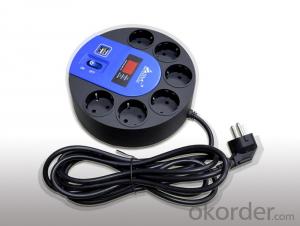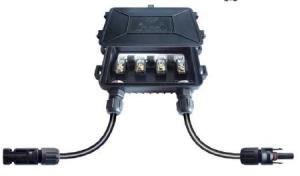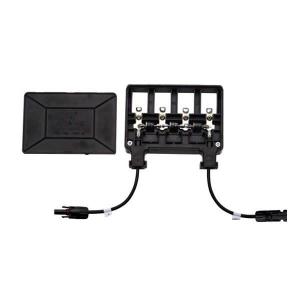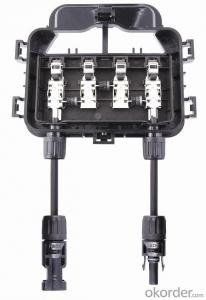Solar Junction box PV-JB030A
- Loading Port:
- China Main Port
- Payment Terms:
- TT OR LC
- Min Order Qty:
- -
- Supply Capability:
- 10000 set/month
OKorder Service Pledge
Quality Product, Order Online Tracking, Timely Delivery
OKorder Financial Service
Credit Rating, Credit Services, Credit Purchasing
You Might Also Like
Solar Junction box,Due to highly robustness,UV-resistance,the touch protection a high grade connection is guaranteed for many .
Solar Junction box,Due to highly robustness,UV-resistance,the touch protection a high grade connection is guaranteed for many years
| Rated voltage | 1000 V |
| Rated current | 6A |
| Contact resistance | ≤5mΩ |
| Protection degree(mated,junction box closed/unmated) | IP65/IP2X |
| Operating temperature | -40 C to +85C |
| Insulation material | PPO |
| Contact material | Copper,silver plated |
- Q: What are the environmental impacts of solar energy systems?
- Solar energy systems have numerous environmental benefits, including reducing greenhouse gas emissions, minimizing air and water pollution, and preserving natural resources. However, the manufacturing and disposal processes of solar panels can generate some waste and require energy inputs. Additionally, land use for large-scale solar installations can impact local ecosystems. Overall, the environmental impacts of solar energy systems are significantly lower compared to conventional energy sources.
- Q: Can solar energy systems be used in areas with limited access to solar energy consultants?
- Yes, solar energy systems can still be used in areas with limited access to solar energy consultants. While the guidance of a consultant can be helpful in designing and implementing an efficient solar energy system, there are plenty of resources available online, including step-by-step guides, tutorials, and calculators, that can assist individuals in setting up their own solar energy systems. Additionally, many solar equipment manufacturers provide technical support and assistance to customers even in remote areas. With the right research, resources, and support, individuals can successfully install and maintain solar energy systems without direct access to consultants.
- Q: What is the impact of shading on solar energy systems?
- Shading can significantly impact the performance and efficiency of solar energy systems. When solar panels are shaded, it reduces their ability to generate electricity as shaded cells produce less power. Even a small amount of shading on a single panel can affect the output of the entire system. Therefore, it is crucial to ensure that solar panels are installed in areas with minimal shading to maximize their energy production and overall effectiveness.
- Q: What is the role of solar trackers in solar energy systems?
- The role of solar trackers in solar energy systems is to optimize the efficiency and output of solar panels by tracking the movement of the sun throughout the day. Solar trackers automatically adjust the position of the panels to ensure that they are always facing the sun at the optimal angle, maximizing the absorption of sunlight and increasing the overall energy generation of the system.
- Q: Can a solar energy system be installed on a museum or cultural institution?
- Yes, a solar energy system can be installed on a museum or cultural institution. Solar panels can be mounted on the roof or in an open space surrounding the building to harness sunlight and convert it into electricity. This can help the institution reduce its reliance on conventional energy sources, lower its carbon footprint, and potentially save on electricity costs in the long run. Additionally, the installation of solar panels can also serve as an educational display, highlighting the institution's commitment to sustainability and renewable energy.
- Q: Can solar energy systems be integrated with existing electrical systems?
- Yes, solar energy systems can be integrated with existing electrical systems. They can be connected to the grid or used in standalone systems, depending on the specific requirements and goals of the user. Integration typically involves the installation of solar panels, inverters, and other necessary equipment to convert sunlight into usable electricity. This integration enables the generation of renewable energy and reduces reliance on traditional power sources.
- Q: Can solar energy systems be used in areas with frequent hurricanes?
- Yes, solar energy systems can be used in areas with frequent hurricanes. However, it is important to design and install them in a way that takes into account the specific challenges posed by hurricanes, such as high winds and potential debris impact. Reinforced mounting systems, robust solar panels, and proper installation techniques can help ensure the durability and resilience of solar energy systems in hurricane-prone areas. Additionally, incorporating battery storage can provide energy backup during power outages caused by hurricanes.
- Q: Can solar energy systems be used in colder climates?
- Yes, solar energy systems can be used in colder climates. While solar panels are most effective in areas with abundant sunlight and warmer temperatures, they can still generate electricity in colder climates. However, the overall efficiency of the panels may be slightly reduced due to lower sun exposure and snow coverage, but advancements in technology have made solar panels more efficient and adaptable to colder climates. Additionally, proper installation and maintenance practices, such as tilting the panels to shed snow and ensuring adequate insulation, can help maximize their performance in colder regions.
- Q: Can solar energy systems be used for powering airports or transportation hubs?
- Certainly, airports or transportation hubs can utilize solar energy systems for power. Solar energy represents a renewable and sustainable power source that can be obtained by installing solar panels. These panels absorb sunlight and convert it into electricity, which can then be utilized to power various operations within airports or transportation hubs. By implementing solar energy systems, a constant and dependable power source can be provided for running lighting systems, air conditioning, heating, ventilation systems, and other electrical equipment. This reduces reliance on conventional energy sources and diminishes the carbon footprint of these facilities. Additionally, airports and transportation hubs often possess expansive roof areas, parking lots, and open spaces, making them ideal locations for solar panel installation. These vast areas can generate a significant amount of solar power, making these facilities excellent candidates for solar energy systems. In fact, several airports and transportation hubs worldwide have already adopted solar energy systems. For instance, Cochin International Airport in India is the world's first airport to be fully powered by solar energy, producing more energy than it consumes. Similarly, Denver International Airport in the United States has installed a large array of solar panels to meet its power requirements. Employing solar energy systems in airports and transportation hubs not only cuts operating costs but also supports environmental sustainability. It aids in mitigating greenhouse gas emissions, reducing dependence on fossil fuels, and contributing to the global shift towards clean and renewable energy sources. In summary, solar energy systems present a feasible and efficient solution for powering airports and transportation hubs, offering various benefits like cost savings, environmental conservation, and energy self-sufficiency.
- Q: Can solar energy systems be used for powering hospitals?
- Yes, solar energy systems can be used for powering hospitals. Solar panels can generate electricity to meet the energy needs of hospitals, reducing reliance on fossil fuels and lowering operating costs. Additionally, solar energy systems can provide a reliable and uninterrupted power supply, especially in remote areas or during power outages, ensuring continuous operation of critical medical equipment and enhancing healthcare services.
Send your message to us
Solar Junction box PV-JB030A
- Loading Port:
- China Main Port
- Payment Terms:
- TT OR LC
- Min Order Qty:
- -
- Supply Capability:
- 10000 set/month
OKorder Service Pledge
Quality Product, Order Online Tracking, Timely Delivery
OKorder Financial Service
Credit Rating, Credit Services, Credit Purchasing
Similar products
Hot products
Hot Searches
Related keywords
























